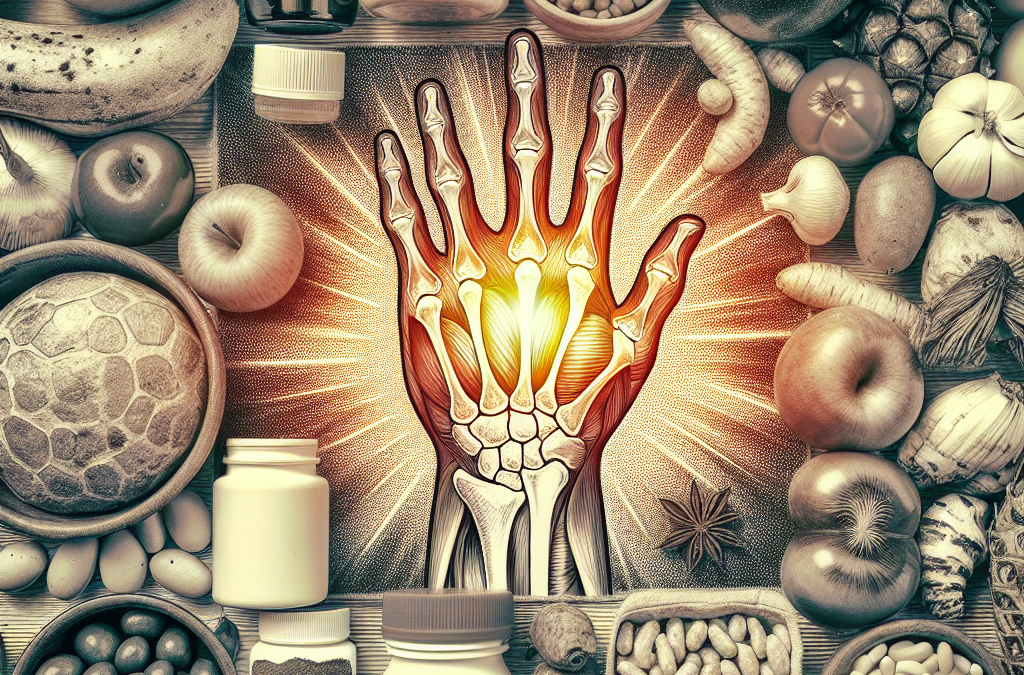Turmeric: The Golden Spice
Understanding Curcumin’s Role
When I first learned about turmeric, I was blown away by all the benefits this golden spice offers, especially for pain relief. The active compound, curcumin, is known for its powerful anti-inflammatory properties. It helps to curb inflammation in the body, which can significantly reduce pain. Imagine trying to tackle that nagging joint pain without resorting to over-the-counter medications; turmeric could be your go-to solution!
I incorporate turmeric into my daily meals, often adding it to curries, soups, and even smoothie bowls. You can also find it in powder form or as capsules if you’re not a fan of its taste. It’s like embracing a little sunshine into your diet, and who doesn’t need that?
Just a little tip: pairing turmeric with black pepper can enhance its absorption, so make sure you sprinkle some on your dishes for an extra kick!
Using Turmeric as a Tea or Supplement
If you’re not into cooking with spices every day, consider making turmeric tea. Simply boil some water, add turmeric, and let it steep. I like to add honey and lemon for a flavor boost. Not only is it comforting, but it also provides that anti-inflammatory punch!
Another option is to look into turmeric supplements. However, always check with your healthcare provider to make sure it’s right for you before jumping in. It’s essential to find a quality supplement to reap the benefits without any unwanted fillers.
Plus, the vibrant color of turmeric is just a bonus. It brightens up your kitchen and your mood as you prepare something wholesome for your body.
Incorporating Turmeric into Your Routine
Getting turmeric into your routine is easier than you’d think! I’ve found that setting a daily intention to include it helps. Whether it’s in your breakfast smoothie or as a spice in your lunch, the goal is to consume it regularly.
Some folks even mix turmeric into their skincare routine, using it for its benefits on the skin. Turmeric face masks are all the rage, and many swear by their soothing properties. So, feel free to pamper yourself while tackling pain!
Once you establish a habit, it becomes second nature. You’ll be surprised at how quickly your body starts to respond positively to consistent intake.
Ginger: A Root with Punch
The Anti-Inflammatory Properties of Ginger
Ginger is another powerhouse in the natural pain relief game. I love it because it has been scientifically shown to reduce muscle pain and soreness. Whether it’s from a tough workout or just a long day on your feet, ginger can be your affable companion.
This root works wonders when consumed fresh, dried, or in oil form. What beats the warmth of a ginger tea after a long day? I always keep some fresh ginger on hand for when a sore throat creeps in or my muscles need a little love.
Like turmeric, ginger is also a worthy player in the anti-inflammatory parade. If you’re looking to ditch pain naturally, incorporating ginger into your meals is a fantastic way to go!
Brewing Ginger Tea
Making ginger tea is as simple as it gets. Just take some fresh ginger, peel it, slice it, and boil it in water. After letting it steep, add a little honey or lemon if you fancy it sweeter. Talk about an instant comfort drink!
The best part? It’s very versatile! You can use ginger to spice up stir-fries, marinades, or even just sprinkle some powdered ginger onto your oatmeal for that extra zing.
Each sip of ginger tea is like a warm hug for your insides. Honestly, it’s one of my favorite rituals, especially on chilly evenings.
Ginger in Cooking
In my experience, incorporating ginger into everyday dishes is a breeze. I love adding it to smoothies or even mixing it into salad dressings. The possibilities are endless!
Not only is it delicious, but it brings a unique taste to your cooking that guests will rave about. Believe me, they’ll have no idea you’re serving up health benefits along with your tasty meals.
Plus, when you make food exciting with ginger, it’s like a secret weapon against pain without sacrificing flavor. That right there is worth celebrating!
Leafy Greens: Nature’s Powerhouse
Why Leafy Greens are Essential
In my journey of seeking natural pain relief, I quickly learned that leafy greens are an absolute must! They’re not just good for you; they can help reduce inflammation and serve as a great source of vitamins and minerals. Spinach, kale, and Swiss chard have been my go-to here.
These greens are packed with antioxidants and essential nutrients that help repair and maintain your body. It’s like giving your body a natural shield against pain and discomfort!
Whenever I feel sluggish or achy, I whip up a big leafy green salad, often topped with a bright vinaigrette to really bring out the flavors. Trust me, it makes a world of difference!
Adding Leafy Greens to Your Meals
Experimenting with salads is one of the easiest ways to incorporate leafy greens into your diet. Blend your favorite greens with fresh veggies, seeds, and a healthy dressing, and you’ve got a delicious pain-fighting meal ready to go.
If you’re not a salad person, consider blending greens into smoothies! You won’t even taste them if you add some fruit and a dollop of yogurt. I promise, it’s way easier than it sounds and incredibly refreshing!
Getting a variety of greens on your plate is essential. Each one has its unique set of benefits and flavors that can make every meal exciting.
Cooking with Leafy Greens
Don’t overlook the cooking possibilities! Sautéing greens in a bit of olive oil or steaming them makes for a perfect side dish. I love tossing in garlic or red pepper flakes for added flavor.
Get an Amazing Discount on the Best Certified Organic Whole Food Supplement!
These cooked greens can complement many dishes, boosting not only the nutrition levels but also the overall satisfaction of your meal. You’ll find that they pair beautifully with proteins or grains!
Plus, the vibrant green color makes your plate so much more appealing. Who wouldn’t want to dig into a colorful, healthy meal? It’s all about making your food appealing and enjoyable.
Berries: Nature’s Sweetest Antioxidants
Why Berries Are Anti-Inflammatory
Let’s talk berries! Strawberries, blueberries, and raspberries are not just tasty; they are full of fiber and antioxidants that can reduce inflammation. They’ve earned top marks on my list of whole foods for natural pain relief because they combine pleasure with health benefits.
I often snack on a handful of mixed berries or toss them into my morning oatmeal. Their sweetness is like a delightful gift to my taste buds while packing a serious nutritional punch to combat pain.
When I need a guilt-free dessert, I’ll whip up a berry smoothie or yogurt parfait. Knowing I’m treating my body right adds to the satisfaction!
Incorporating Berries into Your Daily Diet
Adding berries to your meals is just so easy. They can elevate cereal, salads, or even pancakes. I love how versatile they are! You can snack on them throughout the day, and they’ll keep you feeling full without the heavy calories.
Besides that, I sometimes make a berry compote to pour over whole grain toast or yogurt. It’s refreshing, tasty, and honestly, it looks stunning!
Creating daily habits involving berries might just turn into your new favorite part of eating healthy. You’ll start looking forward to trying new berry-infused recipes!
Freeze Them for Quick Access
One trick I’ve learned is to buy berries in bulk and freeze them! This way, they last longer, and I always have them on hand for smoothies or baking without worrying about them spoiling.
Let me tell you, a frozen berry smoothie makes for the perfect quick breakfast when you’re on the go! Just blend them into a smoothie, and you’re out the door feeling fantastic!
Storing them this way means you kickstart your day right, and as an added bonus, you’re giving your body the help it needs in combating pain.
Cherries: The Juicy Pain Reliever
How Cherries Reduce Pain
Cherries, especially tart ones, are another favorite of mine! They’re renowned for their ability to reduce inflammation and muscle soreness, thanks to their high anthocyanin content. This antioxidant power is something I make sure to leverage whenever possible!
I often enjoy cherries seasonally, but I also look for frozen tart cherries; they work like a charm. Simply incorporating them into my routine feels like a simple yet effective way to fight off discomfort.
Plus, they’re sweet and juicy, making them a delightful snack. Who doesn’t love a handful of cherries on a warm summer day?
Ways to Enjoy Cherries
There are countless ways to enjoy cherries! You can add them to smoothies, salads, or desserts. Cherries in a salad with feta and almonds? Amazing!
They can also be cooked down into sauces or compotes for glazes on dishes like chicken or pork. It’s like giving your meals a little gourmet touch without needing a cooking degree!
And of course, cherry jam is another delicious option for breakfast. Slather it on a piece of toast, and you’re ready to start your day right.
Storage and Preparation Tips
Make sure to store cherries in the fridge to keep them fresh as long as possible. If you’re dealing with excess cherries, try pitting and freezing them. This way, you’ve got a supply ready for smoothies or baking later!
When enjoying fresh cherries, I often like to wash them and enjoy them whole or cut in half. Who knew that such a simple snack could be so beneficial?
Being able to snack smartly is an invaluable skill. And if something as delicious as cherries can help reduce pain, then count me in!
FAQ
1. What are the best whole foods for natural pain relief?
The best whole foods for natural pain relief that I’ve found include turmeric, ginger, leafy greens, berries, and cherries. They all have their unique properties that help reduce inflammation and pain.
2. How can I incorporate turmeric into my diet?
You can incorporate turmeric by adding it to your meals such as curries, soups, or smoothies. You can also try turmeric tea or look for it in supplement form.
3. Are there any side effects of using these whole foods for pain relief?
While these foods are typically safe, it’s always a good idea to consult your doctor, especially if you’re on medication. Some foods may affect absorption or interact with certain medications.
4. How often should I consume these whole foods for effective results?
Making these foods a regular part of your diet is key. I suggest incorporating them into your meals daily for the best results over time.
5. Can I rely solely on these foods for pain relief?
While these foods can be incredibly beneficial, I recommend viewing them as part of a holistic approach to pain management, which can include exercise, therapy, and, when needed, medication.




